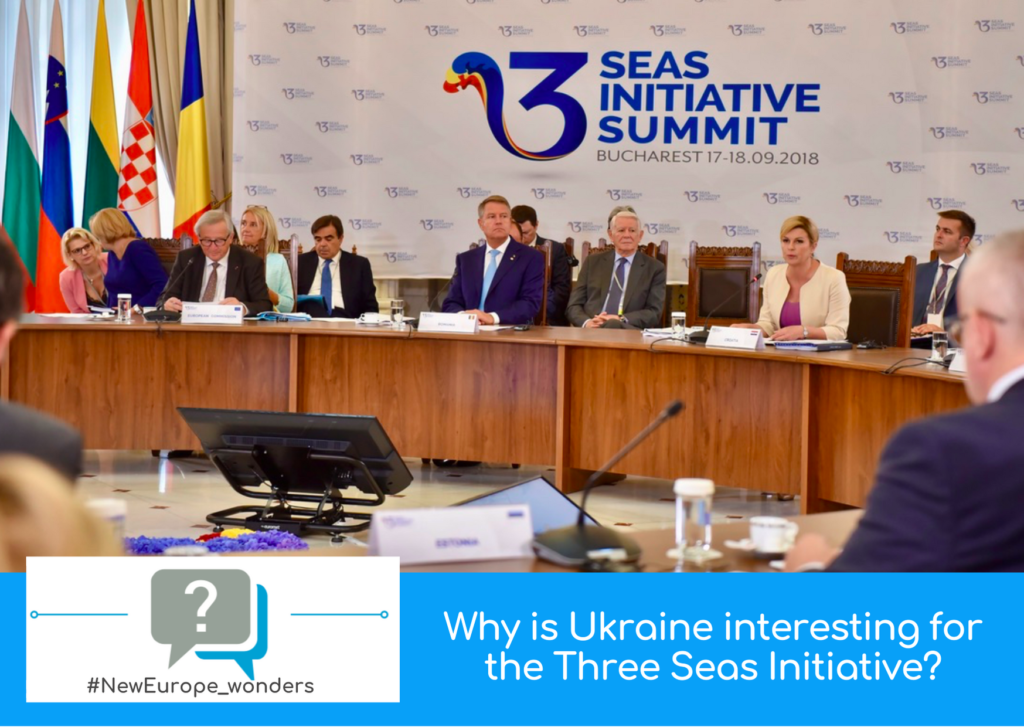The paper is written within the rubric “New Europe Wonders” .
The PDF-version is available here.
The paper was also published on the web-site of the “TSN” media ( in Ukrainian).
The Three Seas Initiative has transformed from an idea into an ambitious project in a few years. Ukraine was invited to take part in the first TSI summit in Dubrovnik (Croatia) in 2016, but did not delegate its representative. Despite the country’s involvement in several TSI projects, overall cooperation has been limited. Today Ukraine clearly emphasizes its desire to join the Initiative. Therefore, the question arises as to what could be the added value from Ukraine for the Three Seas Initiative. In view of the fifth summit of the Three Seas Initiative in Estonia, within the traditional rubric “New Europe Wonders…” the New Europe Center received answers to this question from foreign experts from the countries participating in the Three Seas Initiative.
Expert recommendations:
- Ukraine is able to contribute to the formation of a more competitive CEE gas market and common energy security (for example, domestic underground gas storage facilities will be useful);
- Ukraine’s geographical location corresponds to the general concept of infrastructure development of the TSI member states from north to south, and its transit potential is able to help the development of infrastructure of all the participants of the Initiative;
- Given the emphasis on the digitalisation of infrastructure projects within the Three Seas Initiative (actively promoted by Estonia), Ukraine’s dynamically developing IT sector could be an attractive partner for the TSI countries in creating digital connections in the region.
Sorin Ioniță, President of think tank “Expert Forum” (Romania)
The current Three Seas Initiative is a predominantly economic project firmly anchored into the EU mechanisms. It stands in contrast to its interwar (failed) predecessor, the Intermarium, which was meant to be more geopolitical and military; this should alleviate historical sensitivities. Twelve EU members belong to TSI now, all of them former communist states with the exception of Austria.
Getting Ukraine closer to TSI would benefit the Union in several ways. First, as another channel of cooperation through projects with its largest Eastern neighbor with aspirations to join. Ukraine is already part of EU’s Danube Strategy (EUSDR), covering Odesa region; more such frameworks are needed. Second, Kyiv would bring to the table invaluable “deep knowledge” about the region, its complexities and risks, which few others possess. Third, it would give TSI a more pronounced Black Sea character, which some members (such as Romania) would surely welcome. Finally, it is awkward to discuss energy projects and security, one of the priorities of TSI investments, without the participation of Kyiv. The political context makes Ukraine a likely supporter of the Common Energy Policy, not individual initiatives which run counter to it, and so a factor of discipline and centripetal action within the Union.
Bartosz Bieliszczuk, Energy Policy Analyst, Polish Institute of International Affairs (Poland)
In the recent years Ukraine has made significant steps which made its natural gas market more transparent. Unbundling and signing interconnection agreements with operators from neighbor countries, short-haul service, incentive to use Ukrainian gas storage etc. – all these factors enable closer cooperation with the EU and the Three Seas Initiative countries. We can already observe that some companies are interested in e.g. using Ukraine’s gas storage, so Ukraine can help to create more liquid, transparent and competitive regional gas market – a goal that the Three Seas Initiative aims to achieve.
Natural gas is one issue, but we can also observe EU’s more ambitious push for renewable/clean energy – and of course it will have an impact on the TSI agenda as well. Ukraine also starts to pay more attention to green energy sources, energy efficiency etc., so it might be a promising area of cooperation in the future.
Krševan Antun Dujmović, Senior Associate, Institute for Development and International Relations (Croatia)
Ukraine’s added value for the Three Seas Initiative could be immense. Ukraine, especially its Western part historically represented a part of polities whose territories are now within 3SI countries. Geographically and culturally, this is a unified area. 3SI countries with Ukraine would be as big as one third of the EU, and bigger than Russia, in terms of demography. This would give a much stronger position to the 3SI in Europe and globally. These countries together could also foment their energy independence by interconnectors connecting the regions on three seas, while diminishing dependence on imports of gas from Russia. Ukraine as a member of 3SI could have economic benefits, and other counties of the Initiative would boost their position in Brussels. Involving Ukraine would also have a positive impact on digital and transport infrastructure and the development of all 3SI countries. It could be said that the 3SI is to a large extant incomplete without Ukraine as this country stands at the core of the geographic axis of the Initiative and offers immense potential for developing projects beneficial for the whole of the countries that make part of the 3SI.
Daniel Szeligowski, Head of Eastern Europe Programme, Polish Institute of International Affairs (Poland)
Even though not being its member, Ukraine is well suited to make a significant contribution to the Three Seas Initiative. In fact, it holds cards strong enough to deliver in all three major TSI fields of interest: transport, energy, and digital. First, Ukraine constitutes a transit territory between the Baltic and Black Seas, and therefore fits neatly into TSI core concept of north-south infrastructure development – even if we do not take into account the Ukrainian Black Sea ports, the shortest route from Gdansk to the Romanian port of Constanta still leads through Western Ukraine. Second, Ukrainian gas infrastructure – especially gas storage facilities – represents considerable assets in terms of integrating CEE energy market and securing gas supplies to the region. Third, Ukraine’s booming IT sector has a potential to become an attractive partner for the TSI countries in building digital connections in the region. Obviously, a heavy load of Ukrainian investment would be required beforehand to ensure that the abovementioned opportunities are not lost (such as further development of border infrastructure), which will not be easy given the negative economic consequences of the COVID-19 pandemic. Yet, provided there is political will as well as bit of creativity, Ukraine would be able to match its financial needs and even co-finance joint projects by means of EIB and EBRD loans, to name a few.
Tadeusz Iwanski, Head, Department for Ukraine, Belarus & Moldova, The Center for Eastern Studies (Poland)
3SI is an initiative reserved for EU member states, however it foresees the observer status. Germany and the US have such a status and took part in summits: in Bucharest (2018) and Ljubljana (2019), in Warsaw (2017) respectively. Ukraine was invited to take part in the first summit in Dubrovnik in 2016 but did not delegate a representative.
3SI is not a geopolitical project, no matter there are trends within the individual member states to give it more security-oriented character in cooperation with the US. Roughly speaking, the initiative was established and its goal is to boost investments in infrastructure to enhance north-south corridors in energy, transport etc., using available EU funds. In Ukraine the initiative is mostly and incorrectly viewed as a security one, erroneously perceived as a continuation of the pre-war Intermarium. Such interpretation can be observed in articles by Oleksiy Goncharenko (MP, European Solidarity) or recent Sviatoslav Yurash’ (Servant of the People) initiative to create a group of MP in the Supreme Council of Ukraine.
With these notions in mind and an option to acquire the status of observer, Ukraine – as a country that declares the will to join in – should come to terms internally what 3SI is, what it wants from it, and what are the know-how or resources Kyiv could contribute with for the general up-grade of the initiative. Why non-EU countries are excluded from the 3SI we can spot on the example: theoretically, the construction of one of the most important 3SI infrastructure projects – the Via Carpatia motorway connecting Lithuania and Greece – through the territory of Ukraine would ensure a shorter route and lower costs. On the other hand, however, as Ukraine is neither able to use EU funds available for the member states, nor belongs to the Schengen area, the construction of the Ukrainian section of the motorway could take much longer and the use of the motorway for the EU citizens would be difficult due to border points.








